Abstract
The work is devoted to the study of the role of social competence in the formation of safe behavior in adolescents. The theoretical review analyzes various theories and concepts of social competence, discusses its structural components. The knowledge about the structure of society and the accepted system of relations in it, as well as about the social norms that govern these relations, are determined as key components of social competence. Among the necessary skills and abilities are the possession of the means of verbal and non-verbal communication, the skills of social reflection and self-reflection, as well as self-regulation and self-organization. The personal characteristics of a socially competent person are called criticality, self-confidence, a stable I-concept, a formed hierarchy of motives, developed volitional structures and responsibility. The empirical part presents the results of a study of the relationship between the components of social competence and safe behavior in adolescents. It was revealed that adolescents have rather mediocre knowledge about threats and rules of safe behavior in various social situations. An uncritical self-esteem was established, expressed in a tendency to overestimate one's personal qualities, knowledge and skills. A rather low level of development of reflexive skills was revealed even in those subjects who can be attributed to the group of older adolescents. The leading role of various forms of reflection in the development of safe behavior in adolescents has been established.
Keywords: Social competence, safe behavior, reflection, self-reflection
Introduction
The technological progress rapidly changes the modern society. The electronic technology industry brings dozens of new offerings to the market every day, increasing the already wide range of teenage hobbies. Thanks to electronic communication systems, among the modern generation of young people, new fashionable trends appear and take on a massive character, some of which are associated with the popularization of offenses, others with extreme entertainment (roofing, catching, skywalking, planking, etc.), calls for an additive lifestyle or self-destruction, etc.
The very environment of a young person becomes different. The virtual world and the real world intersect, mutually influence each other, transform habitual attitudes, values, ideals, stereotypes, norms and models of social behavior. In this regard, the question arises: are the requirements for the adaptive capabilities of a young person changing? What psychological resources, personality traits, knowledge, abilities and skills should be formed in a teenager in the first place in order to provide them with effective adaptation in the modern world (both virtual and real).
Our assumption was that the main condition that ensures the effectiveness of survival in the social environment in which a person lives or which they learn anew is the ability to understand it, understand the principles and laws of its organization, consciously engage in a complex system of social relations, adequately reflecting it norms and rules. These skills and abilities are constituent components of the concept of social competence and determine the successful functioning of the subject in the social space.
Problem Statement
The topic of social competence is widely represented in the works of Brushlinsky (2002), Kunitsina et al. (2003), Kalinina and Lukyanova (2003), Mel (1995), Belyaeva (2005), Korol (2014) and others. Considering this phenomenon from different angles, the authors talk about different properties and structural components of social competence but agree on the general meaning of this concept.
The word competence itself comes from the Latin language and means appropriate, suitable. Based on this definition, social competence is interpreted as the level of social activity, determined by the level of development and awareness of social reality by a person. In the works of other authors, this concept is clarified, and its cognitive, emotive and conative components are revealed (Korol, 2014; Kunitsina, 1995; Kunitsina et al., 2003). Social competence is presented as a system of knowledge about the surrounding reality and about oneself, a system of complex social skills and abilities that allow a person to quickly and efficiently make decisions in difficult circumstances, fixed scenarios and models of typical behavior that meet the norms of society and allow a person to quickly adapt in social space making the most of changing circumstances. Social competence is associated with legal and moral maturity, which implies conscious and responsible decision-making (Kamenskaya, 2012).
In the works of other scientists, social competence is considered as an adaptation mechanism based on communicative competence and socio-psychological organization. It is interpreted as the ability of an individual to determine their social guidelines, and in the process of life to organize their activities in proportion to these guidelines (Koblyanskaya, 1995).
Exploring the processes of overcoming crises associated with a change in the way of life among East Germans, Mel (1995) came to the conclusion that the key factor ensuring their effectiveness is the image of the "I". It is the idea of oneself and one's personal resources that provides a person with psychological stability and efficiency in a crisis situation.
In foreign works, the concepts of social competence and social intelligence are often associated, interpreting them as the ability to adequately and effectively respond to various problem situations that arise in life.
Argyll (2003) names the ability to adequately perceive the results of one's actions (feedback), social perception, emotional stability (as opposed to anxiety), and formed interaction skills as key components of social competence. He also emphasizes the importance of the operational, motivational and behavioral aspects of social competence, but considers their main function in the context of ensuring complex interpersonal interaction.
From the perspective of social adaptation, Kaning (2005) emphasizes the importance of such a quality as the subject's ability to adequately perceive the values and norms of the society in which they are located, which echoes the concept of Brushlinsky (2002).
As can be seen from the review, all concepts are built around the same key concepts and represent social competence as a system of multi-level interrelated abilities, skills and abilities involved in resolving difficult life situations and including:
the ability to reflect on situations of interpersonal interaction and adequately identify them;
the ability to understand the actions, intentions and motives of others;
the ability to see alternative ways of solving problem situations;
the ability to predict the consequences, and based on them, build subsequent actions.
the ability to identify resources to achieve goals;
using appropriate means in specific situations to solve problems.
The personal characteristics of a socially competent person are responsibility, adequate, corresponding to the level of aspirations, self-esteem, the folded hierarchy of motives of activity and the formed skills of its organization, reflexivity and critical thinking, empathy, formed skills of effective interaction with others, the ability to self-regulation and willpower.
How are social competence and psychological safety related?
Baeva (2002) considers psychological safety as a mental state of an individual, characterized by the ability to adequately respond to the emerging danger and the individual's feelings about the quality of his security.
The structure of psychological safety according to Baeva (2002) includes:
cognitive component that includes awareness of the sources of danger and the ability to resist them, knowledge of ways to get out of critical situations, as well as the desire for self-actualization and self-knowledge;
emotional-volitional component that includes emotional stability in situations of negative impact;
behavioral component that includes the skills of interpersonal interaction, orientation of behavior to the norms of society and the implementation of protective measures to ensure psychological safety.
Along with psychological security, some authors separately consider information security. Information threat in the definition of Babash et al. (2019) is a danger in the content of which there are various kinds of information and its combinations, which can be used against a social object in order to transform its needs, orientations and interests in accordance with the goals of the information subject. Accordingly, information security is defined as a comprehensive and reliable protection of an individual from the influence of a specific type of threat on him, which appears in variations of information flows aimed at distorting individual and social consciousness.
Luchinkina and Yudeeva (2015) introduce the concept of information-psychological immunity, presenting it as an integral property of a person, which consists in the ability to process, critically analyze information received and broadcast on the Internet. They consider necessary to provide "psychological support for the Internet socialization of adolescents in order to increase information and psychological immunity in the Internet environment" (Luchinkina & Yudeeva, 2015, p. 22).
But the internet is not the only source of danger. The work of the team of the Institute of Social and Political Psychology of the Academy of Pedagogical Sciences of Ukraine showed that adolescents, left without the attention of their parents, become objects of purposeful hunting of various asocial or antisocial groups. These subjects may have different reasons for involving adolescents, but the mechanism of involvement is often the same: arousing interest, playing on curiosity, on complexes, unfulfilled needs, manipulation and distortion of reality (Khairova, 2005).
Research experience has shown that in order to resist such an impact, a certain level of social knowledge and skills is required, and not so much at the theoretical level as at the level of practical skills. Of course, in adolescence, it is still too early to talk about formed social competence, since it is at the initial stage of its formation. It is all the more important to understand which of its components are most related to the safety of behavior and require priority attention in terms of their development.
Research Questions
Based on the above, the relationship between the components of social competence and the effectiveness of safe behavior in adolescents has been determined as the subject of this study.
Purpose of the Study
The purpose of the work is to identify the most significant components of social competence from the point of view of psychological safety, to substantiate practical recommendations for the development of programs for the formation of safe behavior skills in adolescents in social and virtual space.
Research Methods
An empirical study of the relationship between the components of social competence and the safe behavior of adolescents was based on a comparative analysis of the safe behavior of representatives of two age groups: junior adolescents (10–11 years old) and older adolescents (14–16 years old). The sample consisted of 68 pupils from one of the comprehensive schools of the Kerch region.
In accordance with the objectives of the study, various components of the social competence of adolescents were examined, the ideas of adolescents about safe behavior were studied, the relationship between the components of social competence of adolescents and reflexive forms of safe behavior was established.
The study used the following methodological tools: the questionnaire of social skills of D.N. Khlomov and others; A.V. Karpov's reflexivity questionnaire, which gives an idea of the development of various forms of reflection; A.N. Oryol's method for determining the tendency to deviant behavior, designed to measure the readiness of adolescents to implement various forms of deviant behavior; Dembo-Rubinstein method for diagnosing self-esteem and level of aspirations; Rosenzweig test "Method of drawing frustration", children's version (modified by N.V. Tarabrina); the scale of social competence A. M. Parishioners, and various tests of life safety (basics of life safety) revealing the ideas of adolescents about safe behavior in various situations as well. In the two age groups, they were different and corresponded to the age of each group of subjects.
Findings
The analysis of empirical data showed the following results. According to the tests of basics of life safety, adolescents gave slightly more than half of the correct answers (Fig. 1). The conclusion suggests itself that children have very mediocre ideas about the threats that exist in various situations, and accordingly they do not know what actions must be taken to avoid negative consequences.
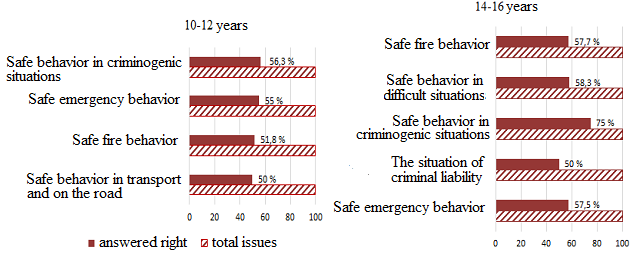
Most of all, the adolescents are aware of the rules of behavior in situations that pose a threat to life and health from other people. And this is quite logical, parents from an early age instill in their children: "Do not go far from me, otherwise someone might take you away!" Probably, such a threat, lying on an instinctive need for protection and security, ultimately takes the form of ideas about how to avoid situations associated with a threat from other people. Speaking about safe behavior in general, it can be noted that there is a tendency for adolescents' awareness to increase as they grow up and accumulate life experience.
The analysis of stable types of response in problem situations showed relatively small differences in the behavior of adolescents in the two age groups (Fig. 2). The most pronounced types of responses to frustration in adolescents are intrapunitive (i) and impunitive (m) reactions with fixation on satisfying a need (NP). The non-accusatory (impunitive) orientation of the subjects' reactions suggests that in frustrating situations, it is typical for adolescents to show habitual childish compliance and conformity in the hope of a positive solution to the problem, as well as to resort to the help of other people.
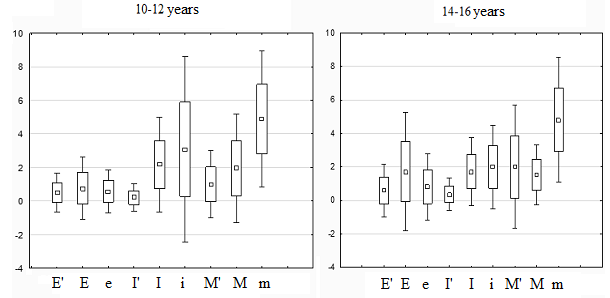
Recognition of their responsibility and the willingness to independently correct the problem that has arisen, in accordance with an impunitive orientation, indicates an infantile (childish) reaction "I will fix everything!" In terms of trends, it can be noted that with age, the proportion of these types of reactions in the general style of response relatively decreases, and the obstructive-dominant and defensive type of response (focus on overcoming the barrier) increase their contribution.
The propensity to deviant behavior due to the specificity of the instrumentation itself was studied only in older adolescents. Figure 3 shows which part of the adolescent sample demonstrates high scores on various scales of deviant behavior.
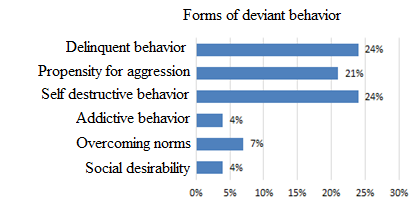
The most pronounced values are on the scales "tendency to delinquent behavior", "tendency to self-destructive behavior and self-harm" (this includes suicidal tendencies), "tendency to aggression and violence." We emphasize that this is only a tendency to demonstrate a certain behavior, and not the behavior itself; however, even a mental projection may indicate the inner emotional stress of the adolescent.
The analysis of self-assessments on different scales showed that younger adolescents tend to overestimate their characteristics, especially intelligence, authority and self-confidence (Fig. 4).
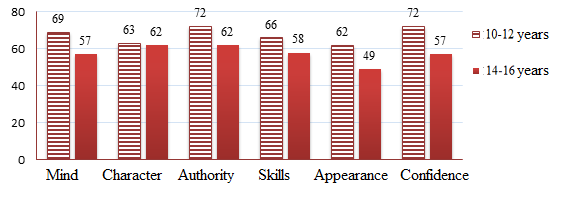
The self-assessments of older adolescents can be called more adequate, which is probably due to their greater self-criticism. These results are in good agreement with the indicators of reflexivity and its dynamics in two age groups (Fig. 5)
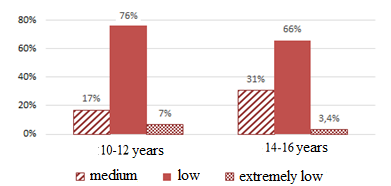
As can be seen from the graphs, both in the younger and older adolescent groups, the observed level of expression of reflexive skills is recorded as low. A high level of reflexivity is not noted in any of the groups. There are few adolescents with an average level of expression of reflexive skills (especially in the younger adolescent group). An increase in the level of reflexivity in the older adolescent group can be noted as a tendency. This may indicate that social reflection, being a very complex social skill, is still at the initial stages of its formation in early adolescence. With the growth of social experience, an adequate awareness of oneself and one's environment is formed, the level of self-criticism rises, which is reflected in self-assessments (Fig. 4).
The indicators of an objective assessment of social skills in adolescents, obtained using the methodology of A. Prikhozhan, confirm this conclusion. Their formation can be assessed as average in both adolescent groups (Fig. 6).
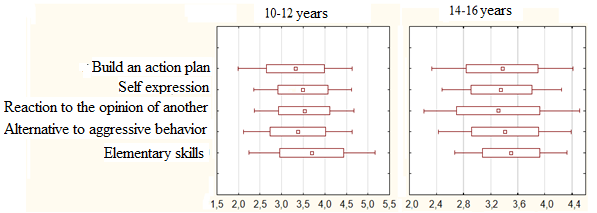
The most developed are initial skills, which are interpreted as some minimum skills that allow a person to come into contact with other people and participate in a conversation. The greatest variation is observed on the scale of "ability to perceive the opinion of another person." A high range of values indicates that this feature is in the zone of active formation and some part of the sample has already reached high values, and some is still in the zone of minimum values.
The analysis of correlations between the parameters of safe behavior of adolescents with various components of social competence was carried out using the statistical technology of complex assessment of the correlation pleiades by T.Yu. This approach made it possible not only to determine the nature of the relationship between the indicators of safe behavior and the parameters of social competence, but also to determine their factorial dependence. It should be noted that in all test situations, a stable connection between reflexive skills and skills of safe behavior was found. This means that adolescents who have shown a high level of development of reflexive skills can recognize signs of a threat, where the situation is outwardly still calm, they know how to better behave in dangerous situations, give an account of their actions and are able to foresee the possible consequences of certain actions. The correlation between social competences and safe behavior are illustrated in Fig. 07.
It was also found that safe behavior is closely related to planning skills and the ability to adequately respond to the words of another. The nature of the relationship shows that the more developed these properties and skills, the higher the probability of resolving dangerous situations with a favorable outcome.
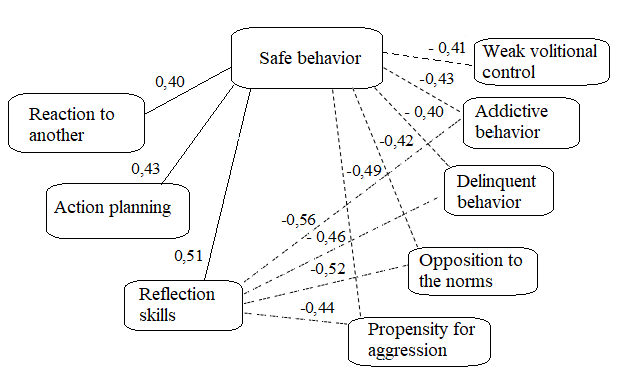
Multiple negative connections between safe behavior and deviant behavior indicate that children with behavioral disorders or with tendencies towards them cannot recollect and solve the problem in extreme situations. Obviously, poorly formed volitional control does not make it possible to remain calm and restrained and provokes panic.
Conclusion
Summing up the results of theoretical and empirical studies of the relationship between the components of social competence and the skills of safe behavior, we can say the following.
Social competence is a system of knowledge about the structure of society, the assimilation of the values and social norms of society; knowledge about oneself as a social subject; the ability to adequately respond to the difficulties encountered in the system of social interaction, the ability to achieve their own goals without harming others.
Social competence in adolescence is still at the initial stages of its formation and manifests itself in a low level of development of various forms of reflection, uncritical thinking, the presence of destructive decision-making styles and the inability to find alternative solutions in cases of problems, a tendency to deviant behavior and a high level of infantilism. This is due to little experience, the desire to be independent and adult, the desire for self-affirmation, rebellious moods, susceptibility to destructive influences from the outside.
It was found that adolescents with pronounced volitional self-control do not have a tendency to deviant behavior, while adolescents with reduced volitional control indices have high connection indicators.
The study of the relationship between social competence and the skills of safe behavior made it possible to establish that safe behavior is associated primarily with developed skills of reflection. The level of reflexivity determines the manifestation of the following qualities: critical perception of events in the external environment, self-understanding, the ability to predict and recognize the signs of an impending threat, competent perception of acts of social interaction.
In addition, the pronouncement of safe behavior is associated with the skill of organized behavior and controlled emotional reactions to external events (phenomena and people). That is, the more developed these properties and skills are, the higher the likelihood of a successful resolution (or avoidance) of a dangerous situation.
The main components of social competence, which should be formed in an adolescent, first of all, are the skills of social reflection and self-reflection, responsibility, an adequate I-concept, the corresponding level of self-assessment of claims; critical thinking; mastering the skills of effective interaction in society; development of self-regulation skills and willpower.
References
Argyll, M. (2003). The Psychology of Happiness. Peter.
Babash, A. V., Larin, D. A., & Baranova, E. K. (2019). Information security. History of special methods of cryptographic activity. Moscow.
Baeva, I. A. (2002). Psychological safety in education: Monograph. Publishing house SOYUZ.
Belyaeva, T. B. (2005). Social competence model. Bull. of Novgorod State Univer., 31, 8–12.
Brushlinsky, A. V. (2002). About the criteria of the subject. In Psychology of the individual and group subject (pp. 9–33). PER SE.
Kalinina, N. V., & Lukyanova, M. I. (2003). Psychological aspects of the development of social competence of schoolchildren. UIPKPRO.
Kamenskaya, E. V. (2012). Social competence: correlation of scientific theories. Modern probl. of sci. and ed., 1. http://www.science-education.ru/ru/article/view?id=5383
Kaning, P. U. (2005). Soziale Kompetenzen. Hogrefe Verlag. http://www.science-education.ru/ru/article/view?id=5383
Khairova, S. I. (2005). Prophylaxis of drug addiction in children, adolescents and young people. Derzhsotsluzhba.
Koblyanskaya, E. V. (1995). Psychological aspects of social competence. St. Petersburg State University.
Korol, O. F. (2014). Conceptual foundations for constructing a structural-dynamic model of social competence of civil servants. Higher educational institution “University of Economics and Law” KROK, 17, 183–194.
Kunitsina, V. N. (1995). Social competence and social intelligence: structure, function, relationship. Theoret. and appl. Quest. of psychol., 1(1), 48–59.
Kunitsina, V. N., Kazarinova, N. V., & Pogolsha, V. M. (2003). Interpersonal Communication. Peter.
Luchinkina, A. I., & Yudeeva, T. V. (2015). Information and psychological safety of children and adolescents in the Internet space. Sci. notes of the Crimean Engineer. and Pedag. Univer. Ser. Pedag. Psychol., 1, 19–24.
Mel, Y. (1995). Social competence as the goal of psychotherapy: problems of the image of the I in a situation of social change. Psychol. Issues, 5, 61–68.
Copyright information

This work is licensed under a Creative Commons Attribution-NonCommercial-NoDerivatives 4.0 International License.
About this article
Publication Date
17 May 2021
Article Doi
eBook ISBN
978-1-80296-106-5
Publisher
European Publisher
Volume
107
Print ISBN (optional)
-
Edition Number
1st Edition
Pages
1-2896
Subjects
Science, philosophy, academic community, scientific progress, education, methodology of science, academic communication
Cite this article as:
Khairova, S. I. (2021). Social Competence As The Basis For Safe Behavior Of Adolescents. In D. K. Bataev, S. A. Gapurov, A. D. Osmaev, V. K. Akaev, L. M. Idigova, M. R. Ovhadov, A. R. Salgiriev, & M. M. Betilmerzaeva (Eds.), Knowledge, Man and Civilization - ISCKMC 2020, vol 107. European Proceedings of Social and Behavioural Sciences (pp. 744-754). European Publisher. https://doi.org/10.15405/epsbs.2021.05.102

